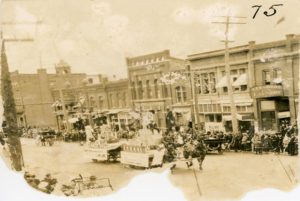
Frederick Thomas Hodgson was a builder and architect who spent much of his life and career in the Collingwood area. Operating around the turn of the century, he contributed many buildings to the growing town that can still be seen and appreciated there today.
Hodgson was born on September 19, 1832, in the town of Selby in Yorkshire, England. In 1847, at the age of 15, Hodgson emigrated to Canada with his uncle, William McDonald, and his aunt and cousins. Initially, Hodgson settled with his relatives at Duntroon, in the township of Nottawasaga. In 1851, at the age of 19, he struck out on his own, moving to the village of Hurontario – what, in a few years, became the town of Collingwood.
As a young man, Hodgson found work as a contractor during the extension of the Northern Railway into Collingwood, erecting some of the houses and sheds that sheltered the workers building the railway line. In 1853, at age 21, Hodgson built his first permanent building on Hurontario Street in Collingwood, on what is now the site of the Globe Hotel.
In 1859, at age 27, Hodgson moved to St. Catharines to take up a job as Superintendent of Rolling Stock for the Welland Railway. He remained there for 17 years.
In 1877, at age 44, Hodgson moved to New York City to take up a job as associate editor of the magazine American Builder. He became managing editor the following year and remained at the helm of the magazine for 12 years.
During this time, Hodgson began publishing a prolific number of guides to practical building and construction techniques, which by the end of his life numbered as many as 144 titles. Hodgson’s best-known book was The ABC of the Steel Square, a practical guide to the use of the carpenter’s square published in 1881. Eventually, the book was published in 20 editions, one as late as 1972, and sold in six countries.
In 1890, at age 56, Hodgson finally returned to Collingwood, where he set up his own business as an architect and builder.
At the time of his return, the town was booming thanks to the arrival of the railway in the 1850s and the beginnings of the local shipbuilding industry in the 1880s. As an architect, Hodgson’s contributions to the growth of the town included the West Ward School and the “Armadale” residence of local cookie company magnate Herbert Y. Telfer on Third Street, both built in 1890. Hodgson also designed “Tornaveen”, the 10,000 square-foot, three-story Queen Anne Revival-style mansion of Herbert Telfer’s older brother Frank, built directly across the street from the younger Telfer’s far more modest home and completed in 1892.
Hodgson also made extensive alterations to the residence of Midland tycoon James Playfair in 1894, as well as an addition to the Globe Hotel, a major expansion of the General and Marine Hospital, and a new gymnasium building for the Collingwood Collegiate Institute, all built in 1895. In 1900, he built the Arlington Hotel on Hurontario Street, as well as a home for local politician and founder of the Collingwood Enterprise John Hogg at Third and Oak Streets.
Throughout the rest of his career, Hodgson worked as editor of National Builder, the Chicago-based magazine that had absorbed his old magazine, American Builder. He also contributed to journals like Canadian Architect and Builder, based in Toronto; Carpenter and Builder and Architect’s Magazine, both based in New York; Dixiein Atlanta, and Craftsman in Cleveland. Hodgson worked mostly by long distance, sending editing suggestions and articles to each journal by mail.
After decades of work contributing to the built landscape of Collingwood and to the professions of architecture and construction in general, Frederick Hodgson died on July 15, 1919, at age 87. The books and magazine articles he wrote can still be found today, and several of the buildings he built are included in heritage walking tours throughout the Town of Collingwood.
Written by John Merritt, SCHA